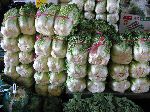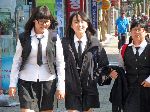Ibike Korea People-to-People Program
 Photo essay: Sangju to
Gimcheon
Photo essay: Sangju to
Gimcheon
Sangju to Gimcheon (34mi, 55km) Beautiful rolling countryside and farmland.
Points of Interest: beautiful hills, rivers and valleys, locations significant
in the Korean War
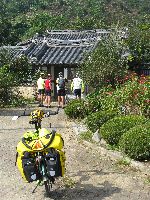
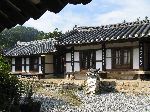 Just out for a morning
ride, and here is a house that is more than 400 years old! This house was
built in 1601 by Jo Jeong (1555-1636), general of the militia during the
Japanese invasion, 1592. It was moved to the present site in 1661. Originally,
the complex of buildings had 40 bays (space between two columns).
Currently, the main building, guest house and a building for ancestral
ceremonies remain.
Just out for a morning
ride, and here is a house that is more than 400 years old! This house was
built in 1601 by Jo Jeong (1555-1636), general of the militia during the
Japanese invasion, 1592. It was moved to the present site in 1661. Originally,
the complex of buildings had 40 bays (space between two columns).
Currently, the main building, guest house and a building for ancestral
ceremonies remain. 

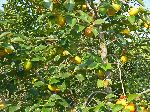 The
vast and intensive agriculture continued. Between the rearranging of the terracing, the
mountains and the village settings the view change every few hundred meters,
mile after mile. Amongst the group we started to have jokes about how many
photos we took of rice fields. We wanted to remember them all. New in this
section was large orchards of persimmons and grapes.
The
vast and intensive agriculture continued. Between the rearranging of the terracing, the
mountains and the village settings the view change every few hundred meters,
mile after mile. Amongst the group we started to have jokes about how many
photos we took of rice fields. We wanted to remember them all. New in this
section was large orchards of persimmons and grapes.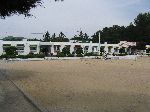
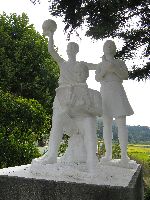 Poking around in a
village during a snack stop, there was a school across the street. Schools
are common. South Korea has a 98% literacy rate. And school
architecture is not distinctive -- it seems like most rural primary schools are
constructed from the same architectural drawing. But tucked up under the
trees next to the gate of this school was a delightful sculpture of students.
I should check to see if there is art next to the gates of other schools.
Poking around in a
village during a snack stop, there was a school across the street. Schools
are common. South Korea has a 98% literacy rate. And school
architecture is not distinctive -- it seems like most rural primary schools are
constructed from the same architectural drawing. But tucked up under the
trees next to the gate of this school was a delightful sculpture of students.
I should check to see if there is art next to the gates of other schools. 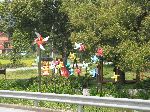
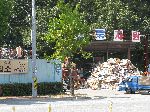
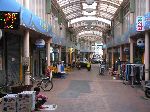
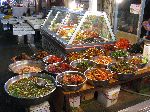
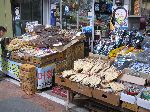
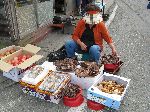
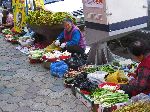
 It was pretty quiet on the afternoon wander through this market. A variety
of shops were open, but there weren't many shoppers. Certainly the staples were
available: kimchi, dried fish and mushrooms.
It was pretty quiet on the afternoon wander through this market. A variety
of shops were open, but there weren't many shoppers. Certainly the staples were
available: kimchi, dried fish and mushrooms.
It may have been the time of day because traffic on main street was also light. The traffic picked up at rush-hour.
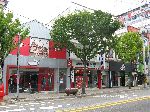
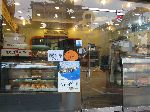
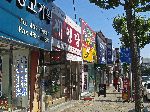 The
sidewalk traffic was much heavier out on the main street. Like in most decent
size towns in Korea, consumers have have access to a variety of international
product. Gimcheon has shops Puma, Adidas, Nike, North Face and a dozen
other international manufacturers. Almost every block in the central city had a
boutique bakery as well. I would venture to say that the amount of bread
and sugar in the average Korean diet is increasing.
The
sidewalk traffic was much heavier out on the main street. Like in most decent
size towns in Korea, consumers have have access to a variety of international
product. Gimcheon has shops Puma, Adidas, Nike, North Face and a dozen
other international manufacturers. Almost every block in the central city had a
boutique bakery as well. I would venture to say that the amount of bread
and sugar in the average Korean diet is increasing.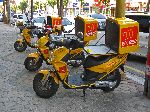
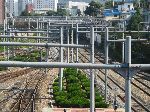 On
the topic of transport modality, Gimcheon has several: MacDonald's delivers
orders by motor scooters.
On
the topic of transport modality, Gimcheon has several: MacDonald's delivers
orders by motor scooters.
The train tracks run through the center of town and the rail yard is active with trains passing through.
In
the afternoon the sidewalks are crowded -- largely with groups of school girls
in uniform. It seems likely that there are some girls schools in the area.
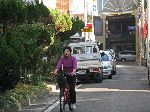 The merchants are happy because they don't seem shy about going into the shop
and spending money.
The merchants are happy because they don't seem shy about going into the shop
and spending money.
Bicycling by locals is rare, but there were a few.
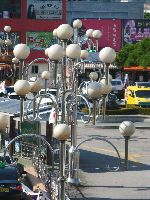
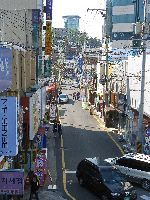 Here are a couple of additional street scenes:
Here are a couple of additional street scenes:The light fixtures in the parking lot of the train station (left).
Looking down a side street across from the train station (right).
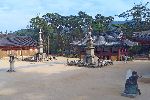
The temple has many classic features of Korean Buddhist temple design.
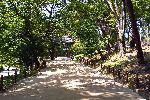
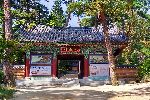 The
second gate is the Bongwangmun, Guardian gate, or Phoenix gate. It is of
Hindu origins. Honors the four Divas. As devotees of Buddha, these figures
guard Buddhist cannons (Dharma) and are the protective deities over monks
and the faithful. Collectively they guard the whole universe: Jiguk
Cheonwang (diva) (lute, the strings of which control wind, thunder, hail
and other weather) rules over the east. Gwangmok Cheonwang (dragon and
jewel -- royalty and wisdom) rules over the west. Jeungjang Cheonwang
(sword) rules over the south, and Damun Cheonwang (pagoda) rules over the
north. At the center of the four quarters is Sumisen. Samisen is where
Buddha lives -- a temple is symbolic of Samisen, therefore, if one passes
this gate he or she is likely to enter the world of Buddha.
The
second gate is the Bongwangmun, Guardian gate, or Phoenix gate. It is of
Hindu origins. Honors the four Divas. As devotees of Buddha, these figures
guard Buddhist cannons (Dharma) and are the protective deities over monks
and the faithful. Collectively they guard the whole universe: Jiguk
Cheonwang (diva) (lute, the strings of which control wind, thunder, hail
and other weather) rules over the east. Gwangmok Cheonwang (dragon and
jewel -- royalty and wisdom) rules over the west. Jeungjang Cheonwang
(sword) rules over the south, and Damun Cheonwang (pagoda) rules over the
north. At the center of the four quarters is Sumisen. Samisen is where
Buddha lives -- a temple is symbolic of Samisen, therefore, if one passes
this gate he or she is likely to enter the world of Buddha.
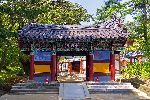

The third gate is Haetalmun, Gate of non-duality, Enlightenment Gate, Nirvana Gate, Liberation Gate. Oneness -- there is no difference where we make judgments and see differences. There is no difference from the mundane world and the spiritual world.
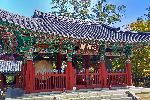
The bell pavilion has four instruments. The Beopgo, Dharma drum, to call all living beings of the land. One end has the hide of a female cow and the other of a male cow. The Mokeo, wooden carp-shaped slit drum, symbolizing the trainees meditating without sleep, and is beat to call all living beings underwater. The Wunpan, flat metal cloud-shaped gong is beat for all of the forlorn wondering spirits, animals and living beings in air. The Bumjong, large bronze bell is beat for all the living creatures in hells. This are played before prayers, calling all things to listen. The bell is struck 28 times every morning (representing the 28 realms of hell) and 33 times in the evening (representing the 33 realms of heaven.)
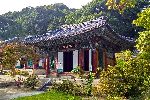
Birojeon (Thousand Buddha Hall), Myeongbujeon (enshrine Ksitigarbha Bodhisativa, the Ten Kings and minor attendants), Samyeongkag hall (enshrines the portrait of the great Buddhist priest Samyeong)
The highest temple in the main compound is often the Temple of the Mountain God. It can be identified by the presence of a tiger. It is adapted from traditional Korean religion.
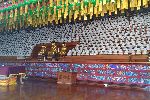
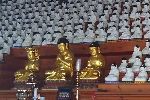 Jikjisa
is one of three temples with a Birojeon. The others are Magoksa and Daeheungsa.
Birojeon is alternatively called the Thousand Buddha Hall. In the front is the
Vairocana triad statues, consisting of Vairocana Buddha, Bhaisajyaguru Buddha
and Nosana Buddha. They are flanked by a thousand Buddha. Among the thousand
Buddha is one baby Buddha. It can be found in the third row, behind the
Vairocana triad statues (right).
Jikjisa
is one of three temples with a Birojeon. The others are Magoksa and Daeheungsa.
Birojeon is alternatively called the Thousand Buddha Hall. In the front is the
Vairocana triad statues, consisting of Vairocana Buddha, Bhaisajyaguru Buddha
and Nosana Buddha. They are flanked by a thousand Buddha. Among the thousand
Buddha is one baby Buddha. It can be found in the third row, behind the
Vairocana triad statues (right).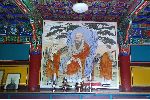

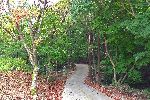
Outside of the temple compound is a plot of buda or stupa. A stupa is a pagoda where ashes or remains of Buddhist saints or monks are placed. Most of these stupa are bell-shaped. The decoration on the stupa indicate when the stupa was dedicated. This was a common practice for monks that lived in the area during the latter part of the Joseon Dynasty.
From the stupa area is a road that leads up into the hills to a half-dozen Ams or hermatiges.
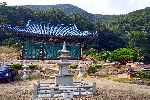
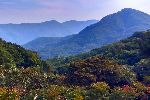
Most temple systems in Korea are built and located is such a way so as to receive the magical energy of its surrounding landscape. The mountain from which they are constructed upon will have what's known as three 'Hyeol' - an upper, central and lower plateau. The 'Gi,' or energy lines that run down the southern slope, will pass trough all three of these plateau and major larger monastery will be built on the lower Hyeols, with its hermitages scattered above on the central and upper Hyeols. The upper hermitages supposedly have higher refined levels of spiritual energy, allowing those that live in them closer access to the energies of the mountain and heaven. The lower level purports a more balanced and powerful energy, hence the construction of large stabilized headquarter temples at the foot of the mountain.
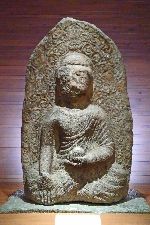
 Please
contact us if you would like to be added to
Ibike's mailing list or have questions, comments, corrections or criticism. (Also, please let us know how you learned about us and
found this site.) Privacy policy.
Please
contact us if you would like to be added to
Ibike's mailing list or have questions, comments, corrections or criticism. (Also, please let us know how you learned about us and
found this site.) Privacy policy.
![]() IBF Homepage
IBF Homepage ![]() Ibike Programs
Ibike Programs
![]() Ibike Schedule
Ibike Schedule
![]() Search
Search
